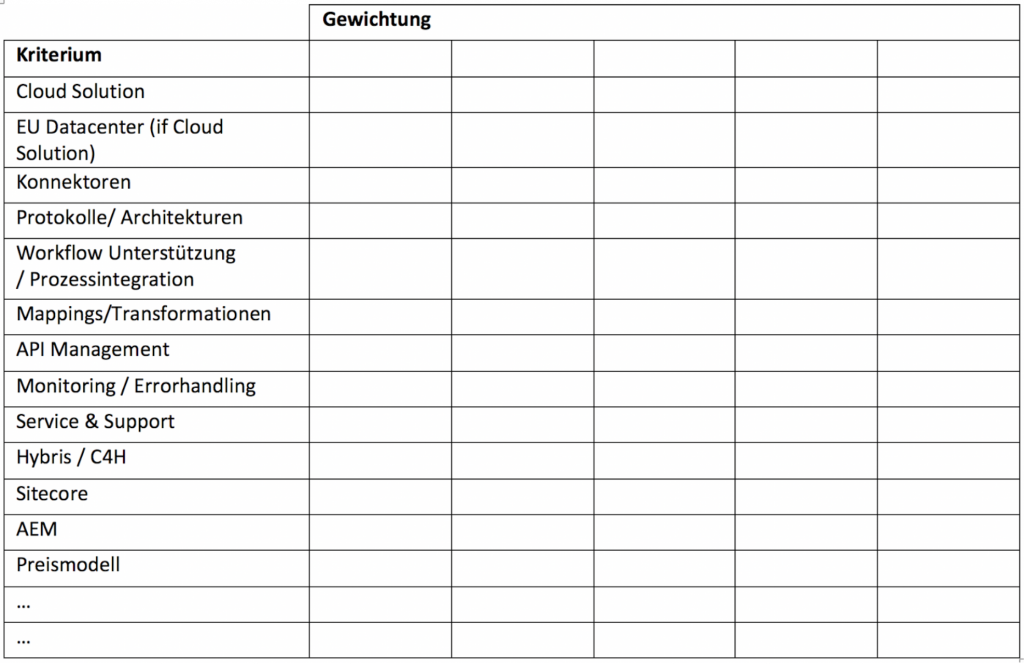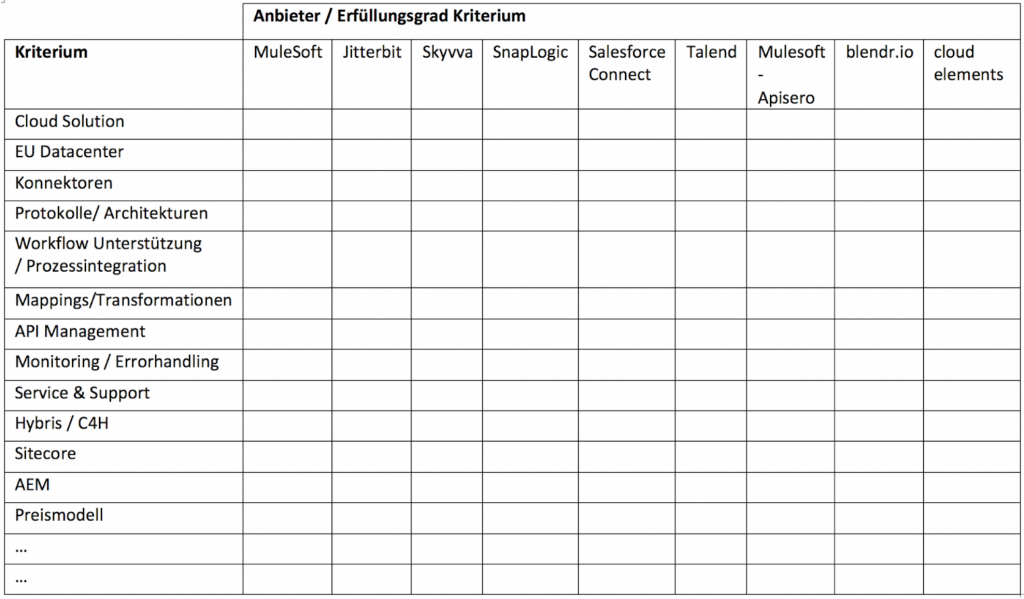Cross-System Salesforce Integration Solution
We give you guidelines for a suitable solution for you and your system
Step by step to the suitable solution for the continuous mapping of your business processes.
It's done, Salesforce has been successfully implemented. At the same time, you need to build a solution that automatically maps your business processes across all systems in use.
In my blog post I will show you how to find the right solution for you in just a few steps.
Guidance
As mentioned at the beginning, it is important to map business processes consistently between the systems.
There is a technical condition to be observed:
Avoid 'hard-wired' / programmed point-to-point connections between the systems!
A middleware solution is needed that can do more than just connect 2 systems individually per identified process. There are currently a large number of such solutions and providers on the market.
Step 1: Define the criteria for selecting a solution
Here is a selection of technical criteria that have proven themselves in my projects for many years:
- Cloud solution (here also: security of transmission / encryption)
- EU Data Centre (in the case of a cloud solution, the provider should offer its solution on servers in the EU for the entire data flow as well as the administration (monitoring/error handling))
- Number and type of connectors (application and technology adapter e.g. SAP, Salesforce, MS Dynamics, JDBC, SFTP, S3, ...)
- Supported protocols / architectures (at least SOAP, REST, OData)
- Workflow/Process support
- Complex mappings/transformations
- API management / conception
- Monitoring and error handling
- SLA / Service & Support (Support staff in EU)
For Merkle as a digital full-service provider, additional criteria are often relevant, as very many of our customers have such solutions in use and therefore need to be integrated into automated processes:
- Connectors for SAP Hybris (SAP C/4HANA), Sitecore, Adobe Experience Manager
The following criteria apply in addition to the technical criteria:
- the price / the price model
- Application examples / references with comparable requirements (Customer stories from various industries and customer sizes)
- Provider Support in EU
Less crucial is the multilingualism of such a solution! The reason for this is that such solutions are almost always implemented by the IT department and later at least administered by IT-related areas. In these areas, English is usually always the language of choice, since software is very often launched in English first.
Step 2: Determine the type of integration / integration types
The questions here refer to the concrete type of integration:
- Is a one-time or recurring data load required (classic ETL) or a complex process integration?
- Must the data be kept in all connected systems (duplication of information) or is (real-time) access and display during the process sufficient?
- Amount of records / throughput / performance: are there single records in real-time or batch processing with several records?
- What quantities per hour / day / week, etc. have to be handled?
- What response times can be expected?
Step 3: Weight your criteria
The next step is to weight all of these criteria customer / project specific.
Since this is considered very individually (size of the company, country, data volumes, IT/business strategies, etc.), no general specification can be made here. One possibility is to list all criteria in a table and weight them, e.g. using a scale of 1-5.

Step 4: Compare possible solution providers
In the comparison, it is important to distinguish not only between 'fulfilled' and 'not fulfilled', but also according to 'how well' the criterion was fulfilled. Here again, individual weightings apply, since, for example, the presence of 'API Management' alone does not say much, but the criterion must be evaluated again according to customer and project.

If you now place these two tables 'on top of each other', that is
"How important is a criterion to me" and
"How well does a solution meet a criterion",
you get the shortlisted candidates.
I recommend that we make a short list of the top 3 candidates.
These will be invited to present their solution in detail - with 2-3 project-specific integration scenarios - of course in the sense of a "proof of concept" (no complete, productively usable implementation)!
Step 5: Summarize the results of your selection
At the end of your selection process you should have a list of possible providers and choose a favourite from it. I have compiled a list of possible solution providers for you, who are always in the focus of Merkle projects:
MuleSoft was bought by Salesforce. The vendor is likely to play a decisive role in the future in the integration of the in-house solutions, since not all of them run on the Force.com platform. Examples are Marketing Cloud, Salesforce Commerce and Salesforce DMP (Krux), where it is necessary to integrate these more closely with the Force.com clouds and thus to connect all processes of the Salesforce solutions consistently and automatically.
The solution offers complex API management, EU Datacenter and a free DataLoader solution (dataloader.io). As a partner solution there is also a SAP Hybris Connector (note at the end).
Since it is not very inexpensive and somewhat more complex to configure, Mulesoft is recommended for large Salesforce customers, especially when using several Salesforce solutions.
Jitterbit
Probably the best alternative to MuleSoft; especially for Salesforce customers, who so far only use Force.com solutions (Sales Cloud / Service Cloud / Force.com platform) and have to integrate several non-Salesforce systems into their processes. Also available: API Management, EU Datacenter, free DataLoader solution (very popular with Salesforce administrators instead of Salesforce DataLoader).
The licensing model is easy to understand.
The solution is also recommendable for small and medium-sized companies, whereby there are no limits to the number of users.
Skyvva is an affordable solution if the focus is on Salesforce - SAP integrations.
The solution is built directly on Force.com and offers all necessary functions (mappings, monitoring and error handling etc.). Therefore no further middleware solution is necessary, because the Force.com platform serves as middleware. Integrations to other ERP systems, databases and file servers are also possible.
Other interesting alternatives:
SnapLogic is a particularly interesting solution from a technical point of view because it offers an AI engine (machine-learning-driven recommendation engine). Very good scaling for large data volumes.
Salesforce Connect / Lightning Connect is a Salesforce proprietary, OData protocol based solution, which is payable per application adapter. Data can remain in the source systems and will not be duplicated (direct display of external information in Salesforce as soon as a linked Salesforce record is displayed). No additional middleware solution is required.
Point-to-Point solution!
Talend is more an ETL tool than a complex process integration solution.
Again, very popular with Salesforce administrators: the free DataLoader version when more complex mappings/transformations are required. Very useful for initial, large data migrations.
Mulesoft/Apisero
Hybris Connector via a partner solution from Apisero
I hope I was able to support you with my blog post on the selection of an integration solution. Merkle will be happy to assist you in planning and deciding on a suitable solution!
I look forward to hearing from you:peter.steinebach@emea.merkleinc.com













